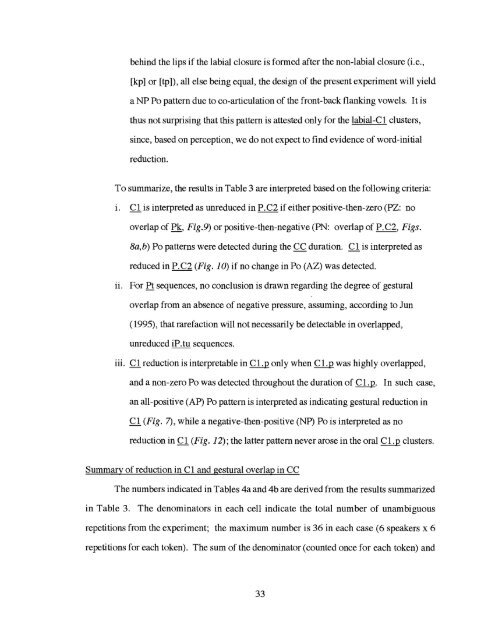A Phonetically-Based Optimality Theoretic Account of Consonant ...
A Phonetically-Based Optimality Theoretic Account of Consonant ...
A Phonetically-Based Optimality Theoretic Account of Consonant ...
You also want an ePaper? Increase the reach of your titles
YUMPU automatically turns print PDFs into web optimized ePapers that Google loves.
ehind the lips if the labial closure is formed after the non-labial closure (i.e.,<br />
[kp] or [tp]), all else being equal, the design <strong>of</strong> the present experiment will yield<br />
a NP Po pattern due to co-articulation <strong>of</strong> the front-back flanking vowels. It is<br />
thus not surprising that this pattern is attested only for the labial-C1 clusters,<br />
since, based on perception, we do not expect to find evidence <strong>of</strong> word-initial<br />
reduction.<br />
To summarize, the results in Table 3 are interpreted based on the following criteria:<br />
1. C1 is interpreted as unreduced in P.C2 if either positive-then-zero (PZ: no<br />
overlap <strong>of</strong> Pk, Fig.9) or positive-then-negative (PN: overlap <strong>of</strong> P.C2, Figs.<br />
Sa,b) Po patterns were detected during the CC duration. C1 is interpreted as<br />
reduced in P.C2 (Fig. 10) if no change in Po (AZ) was detected.<br />
11. For Pt sequences, no conclusion is drawn regarding the degree <strong>of</strong> gestural<br />
overlap from an absence <strong>of</strong> negative pressure, assuming, according to lun<br />
(1995), that rarefaction will not necessarily be detectable in overlapped,<br />
unreduced iP. tu sequences.<br />
iii. C1 reduction is interpretable in Q1& only when C1.p was highly overlapped,<br />
and a non-zero Po was detected throughout the duration <strong>of</strong> C1.p. In such case,<br />
an all-positive (AP) Po pattern is interpreted as indicating gestural reduction in<br />
C1 (Fig. 7), while a negative-then-positive (NP) Po is interpreted as no<br />
reduction in C1 (Fig. 12); the latter pattern never arose in the oral Q1& clusters.<br />
Summary <strong>of</strong> reduction in C1 and gestural overlap in CC<br />
The numbers indicated in Tables 4a and 4b are derived from the results summarized<br />
in Table 3. The denominators in each cell indicate the total number <strong>of</strong> unambiguous<br />
repetitions from the experiment; the maximum number is 36 in each case (6 speakers x 6<br />
repeti tions for each token). The sum <strong>of</strong> the denominator (counted once for each token) and<br />
33
















